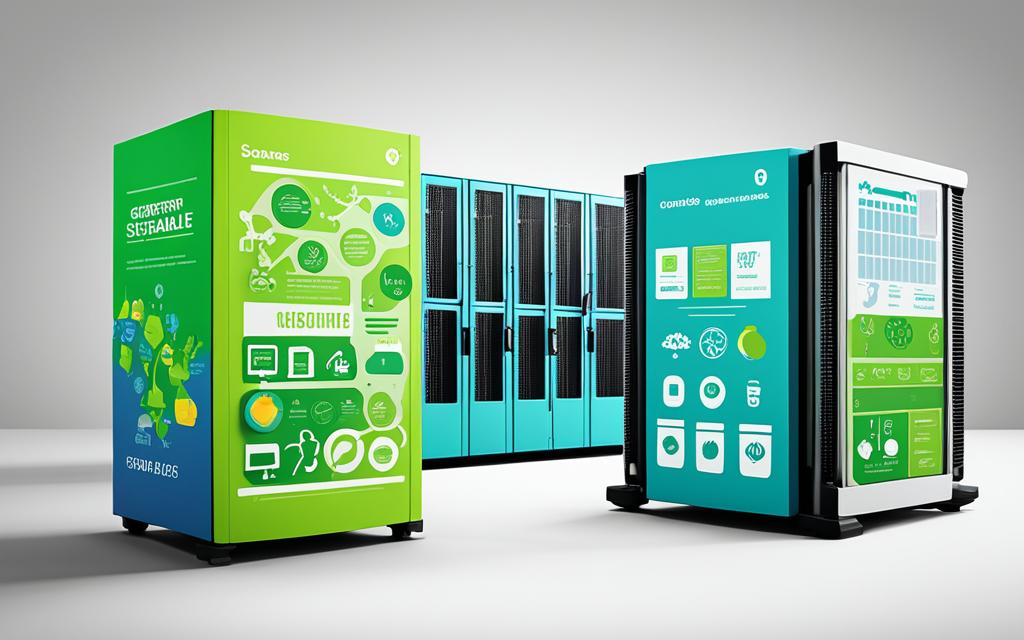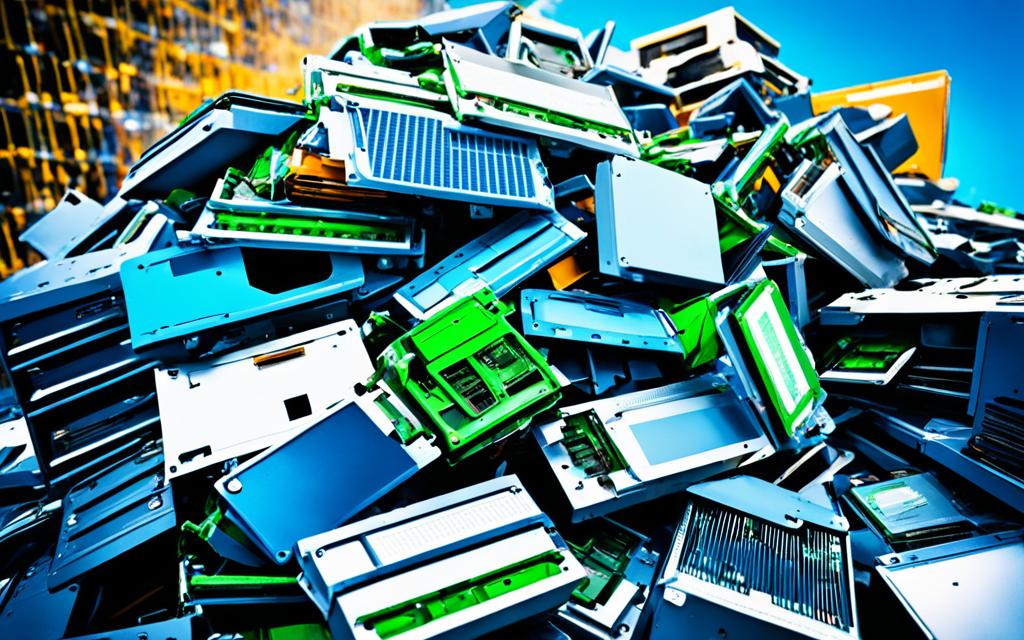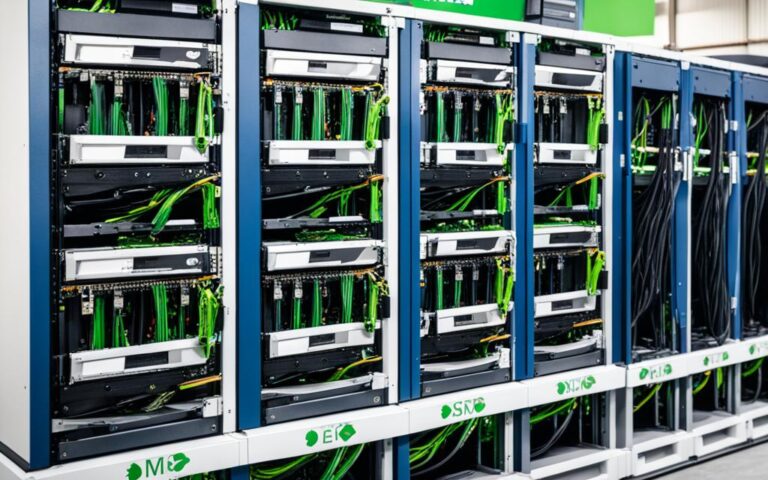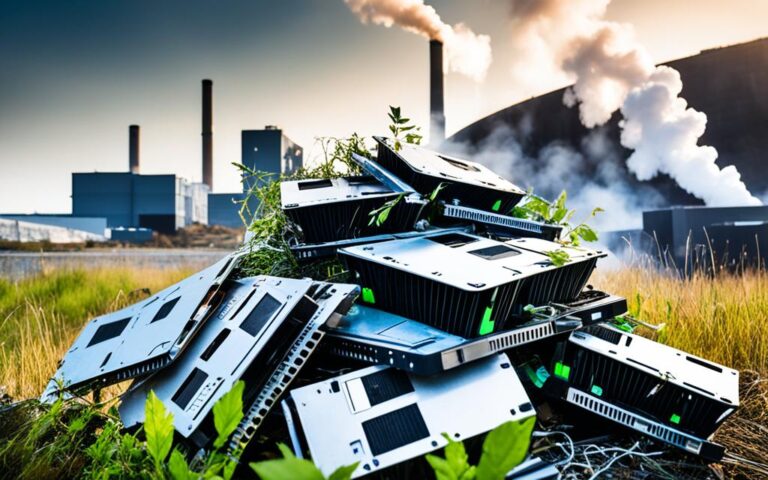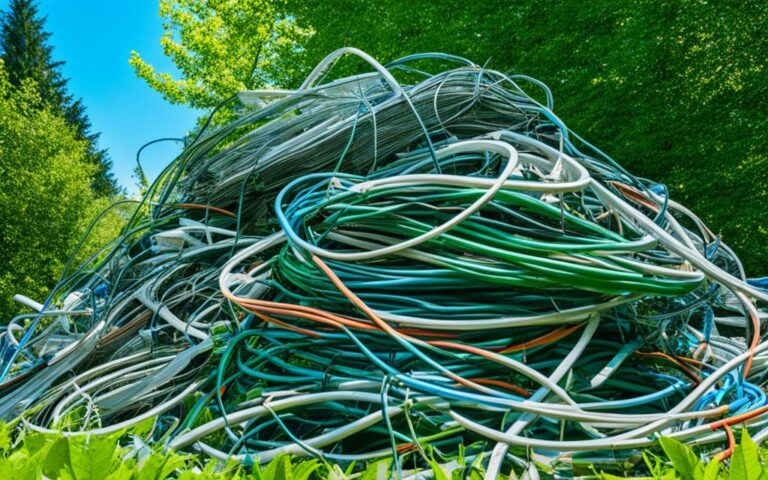The Role of Server Recycling in IT Risk Management
Integrating IT Asset Disposition (ITAD) within risk management strategies is crucial for organizations worldwide. ITAD involves the responsible recycling, reusing, and disposing of old IT assets and electronics. Including a thorough ITAD strategy helps manage the risk of data breaches and violations of data privacy regulations. Proper server recycling is an essential component of IT risk management, as it prevents data breaches and reduces the environmental impact of e-waste.
Server recycling offers numerous benefits for risk management and the environment. It reduces e-waste, conserves valuable resources, and minimizes the carbon footprint of the IT industry. Proper server recycling also ensures secure data erasure, minimizing the risk of data breaches. By partnering with trusted ITAD companies, businesses can optimize their IT infrastructure, demonstrate environmental responsibility, and comply with relevant regulations.
Stay tuned for more in-depth information about IT Asset Disposition (ITAD), the importance of integrating ITAD in risk management strategies, the benefits of server recycling for risk management, the server recycling process for risk management, the risks of improper server disposal, and the environmental and economic benefits of server recycling.
To learn more about server recycling and its importance in IT risk management, visit serverrecycling.co.uk.
What is IT Asset Disposition (ITAD)?
IT Asset Disposition (ITAD) is the process of securely and environmentally responsibly disposing of outdated IT assets. It involves reusing or recycling IT equipment, ensuring data security, and complying with data disposal laws and privacy regulations.
Many organizations rely on professional ITAD companies to handle the complex process of disposing of IT assets. These companies have the expertise and resources to assess, sanitize, and dispose of IT assets effectively and efficiently.
Choosing a reliable ITAD partner is essential for achieving financial and environmental benefits while remaining compliant with data privacy regulations. A comprehensive ITAD strategy not only helps organizations manage their e-waste but also safeguards sensitive information from falling into the wrong hands.
Proper ITAD encompasses various practices, such as secure data erasure, asset tracking, and documented chain-of-custody processes. It ensures that data stored on retired assets is permanently removed, reducing the risk of data breaches and data leakage.
By opting for ITAD, organizations can contribute to sustainable practices, minimize their environmental footprint, and adhere to regulations governing the disposal of electronic waste. It also allows businesses to recover value from retired assets through the refurbishment and resale of reusable components.
Ultimately, ITAD is an integral part of an organization’s overall IT lifecycle management. It facilitates the responsible disposal of IT assets while addressing data security concerns and promoting environmental sustainability.
The Benefits of IT Asset Disposition:
- Secure data erasure
- Compliance with data disposal laws and privacy regulations
- Environmental sustainability and reduced e-waste
- Recovery of value from retired assets
- Reduced risk of data breaches and leakage
Proper ITAD ensures that organizations not only protect their sensitive data but also contribute to a greener future by responsibly disposing of their IT assets.
With the increasing emphasis on data privacy and environmental sustainability, adopting a robust ITAD strategy is vital for organizations in various industries. By partnering with reliable ITAD providers, businesses can maximize the benefits of IT asset disposition and mitigate the risks associated with improper disposal.
The Importance of Integrating ITAD in Risk Management Strategies
All businesses need a comprehensive risk management strategy to identify and effectively manage potential risks. In today’s digital age, data breaches and violations of data privacy regulations pose significant threats to organizations. It is crucial to understand that improper disposal of end-of-life IT assets can lead to data breaches and compromise data security. That’s where IT Asset Disposition (ITAD) comes in as a vital component of a risk management strategy.
Including ITAD in your risk management strategy helps mitigate the risks associated with poor data disposal practices. By considering factors such as data security, compliance with e-waste and data privacy laws, auditable tracking, and environmental stewardship, organizations can effectively minimize the potential risks and ensure proper handling of their IT assets.
“Proper disposal of end-of-life IT assets is an essential risk management measure.”
Integrating ITAD into risk management strategies offers several key benefits. Firstly, it helps safeguard sensitive data by ensuring secure data erasure during the IT asset disposal process. This significantly reduces the risk of data breaches and potential legal and financial consequences. Secondly, ITAD ensures compliance with relevant e-waste and data privacy laws, protecting organizations from penalties and reputational damage.
| Benefits of Integrating ITAD in Risk Management Strategies |
|---|
| Effective data security |
| Compliance with data privacy regulations |
| Auditable tracking of IT asset disposal |
| Environmental stewardship and sustainability |
Lastly, integrating ITAD in risk management strategies demonstrates environmental stewardship and sustainability. By responsibly recycling and disposing of IT assets, organizations contribute to reducing e-waste and minimizing their carbon footprint. This not only benefits the environment but also enhances the organization’s reputation as a socially and environmentally responsible business.
“Integrating ITAD in risk management strategies minimizes risks and promotes environmental stewardship.”
It is clear that integrating ITAD in risk management strategies is essential for modern organizations. By prioritizing secure and responsible disposal of IT assets, businesses can effectively mitigate risks, protect sensitive data, comply with regulations, and demonstrate their commitment to environmental responsibility.
In the next section, we will explore the specific benefits of server recycling for risk management and delve into the server recycling process.
The Benefits of Server Recycling for Risk Management
Server recycling offers numerous benefits for risk management and the environment. By properly recycling servers, businesses can mitigate risks, optimize their IT infrastructure, and demonstrate environmental responsibility. Let’s explore the key benefits of server recycling in more detail:
1. Reduction of E-waste
Server recycling helps reduce electronic waste, which is a growing environmental concern. Discarded servers contribute to the accumulation of e-waste in landfills, leading to pollution and environmental degradation. By recycling servers, businesses can prevent the harmful impact of e-waste and contribute to a more sustainable future.
2. Conservation of Valuable Resources
Proper server recycling allows for the recovery and reuse of valuable resources found in servers, such as metals and minerals. Recycling these resources reduces the need for extracting raw materials, minimizing the environmental impact of resource extraction processes. In addition, the conservation of valuable resources helps ensure their availability for future generations.
3. Minimization of Carbon Footprint
The IT industry is a significant contributor to carbon emissions. By recycling servers, businesses can significantly reduce their carbon footprint. Recycling reduces the energy and resources required to manufacture new servers, resulting in lower greenhouse gas emissions. Choosing server recycling is an effective way to promote environmental sustainability and combat climate change.
4. Secure Data Erasure
Proper server recycling involves secure data erasure, ensuring that sensitive information is permanently removed from the servers. This minimizes the risk of data breaches and data security incidents. By partnering with trusted IT Asset Disposition (ITAD) companies, businesses can ensure that their data is securely erased before disposal, safeguarding their reputation and protecting the privacy of their customers.
5. Compliance with Regulations
Server recycling helps businesses comply with relevant regulations concerning IT asset disposal and data privacy. By partnering with reputable ITAD companies, organizations can ensure that the recycling process adheres to legal requirements and industry standards. Compliance with regulations not only mitigates the risk of fines and penalties but also enhances the organization’s reputation for ethical and responsible business practices.
By considering these benefits, businesses can make informed decisions about incorporating server recycling into their risk management strategies. Prioritizing server recycling enables organizations to maximize the advantages of risk management while promoting sustainability and environmental stewardship.
“Proper server recycling is not only beneficial for risk management but also for the environment. By recycling servers, businesses can minimize their carbon footprint and contribute to a cleaner, more sustainable future.”
The Server Recycling Process for Risk Management
The server recycling process plays a crucial role in risk management, ensuring secure data erasure and effective environmental stewardship. By following a well-defined procedure, organizations can mitigate risks associated with data breaches and minimize their carbon footprint. Let’s explore the key steps involved in the server recycling process:
- Assessment: The first step is to assess the servers to determine their condition and potential for reuse or recycling. This evaluation helps identify any valuable components that can be salvaged or repurposed.
- Secure Data Erasure: To protect sensitive information, secure data erasure techniques are employed. These techniques ensure that all data is permanently removed from the servers, minimizing the risk of data breaches.
- Disassembly: After data erasure, the servers are disassembled. During this phase, reusable components like processors, memory modules, and storage devices are separated from those components that are destined for recycling.
- Component Recovery: Valuable materials, such as precious metals and rare earth elements, are recovered from the components for reuse. This process reduces the need for extracting raw materials and conserves natural resources.
- Responsible Disposal: Any remaining materials that cannot be reused or recovered are sent to certified recycling facilities for responsible disposal. These facilities ensure compliance with environmental regulations and minimize the impact on ecosystems.
By following this comprehensive server recycling process, organizations can effectively manage environmental and security risks, while also contributing to a more sustainable future.
Example Table: Components Recovered from Recycled Servers
| Component | Materials Recovered |
|---|---|
| Processors | Gold, silver, palladium, copper, tin |
| Memory Modules | Gold, silver, palladium, copper |
| Storage Devices | Gold, silver, palladium, copper |
| Power Supplies | Copper, aluminum, steel |
| Network Cards | Gold, silver, palladium, copper |
Risks of Improper Server Disposal
In today’s digital age, the improper disposal of servers poses significant risks to both the environment and data security. Servers, as critical components of IT infrastructure, contain hazardous materials that can have detrimental effects on ecosystems and human health if not disposed of properly. The accumulation of discarded servers in landfills contributes to the growing problem of e-waste, resulting in environmental degradation.
Aside from the environmental hazards, improper server disposal also poses a threat to data security. Servers often store sensitive information, including customer data, intellectual property, and confidential business data. If not disposed of securely, these servers can fall into the wrong hands, leading to data breaches and the compromise of sensitive information.
It is imperative for organizations to prioritize proper server recycling to mitigate these risks effectively. By adopting responsible server disposal practices, companies can minimize their environmental impact, protect the confidentiality of data, and ensure compliance with data privacy regulations.
“The improper disposal of servers not only harms the environment but also exposes organizations to the risk of data breaches. It is essential for companies to embrace responsible server recycling practices to safeguard both their data and our planet.”
To illustrate the importance of proper server recycling, let’s take a closer look at the environmental hazards and data security risks associated with improper server disposal:
Environmental Hazards of Improper Server Disposal
Proper server disposal is essential to prevent environmental hazards. Servers contain a variety of hazardous materials such as heavy metals, toxic chemicals, and carcinogenic substances. When improperly disposed of, these materials can leach into the soil, contaminate groundwater, and eventually enter the food chain, posing serious risks to human and ecological health.
The accumulation of discarded servers in landfills also contributes to the global e-waste crisis. E-waste contains valuable resources like gold, silver, and copper that can be recovered through recycling. However, when servers end up in landfills instead of being properly recycled, these valuable materials go to waste, leading to resource depletion and increased mining activities.
Furthermore, the improper disposal of servers results in the emission of greenhouse gases. As the materials in servers break down in landfills, they release harmful substances such as dioxins and furans, which contribute to air pollution and climate change.
By embracing responsible server recycling practices, organizations can minimize these environmental hazards and actively contribute to the preservation of our planet.
Data Security Risks of Improper Server Disposal
Improper server disposal can have severe implications for data security. Servers often store sensitive and confidential information, making them attractive targets for malicious actors. When servers are not disposed of securely, unauthorized individuals may gain access to the data stored within, leading to data breaches and potential financial and reputational damages for organizations.
Data breaches resulting from improper server disposal can also lead to violations of data privacy regulations. Laws such as the General Data Protection Regulation (GDPR) require organizations to handle personal data responsibly, including its disposal. Failure to comply with these regulations can result in significant legal penalties and reputational harm.
Proper server recycling practices, including secure data erasure and physical destruction, are crucial for mitigating data security risks. By ensuring that all data is permanently and irreversibly removed from servers before disposal, organizations can safeguard sensitive information and maintain customer trust.
Through responsible server recycling, organizations can protect both the environment and their data, contributing to a sustainable and secure future.
| Environmental Hazards | Data Security Risks |
|---|---|
| – Contamination of soil and groundwater | – Unauthorized access to sensitive data |
| – Risk to human and ecological health | – Data breaches and financial losses |
| – E-waste accumulation and resource depletion | – Violation of data privacy regulations |
| – Greenhouse gas emissions and climate change | – Reputational damage and legal penalties |
The Environmental and Economic Benefits of Server Recycling
Server recycling plays a vital role in promoting environmental responsibility and realizing economic advantages. By adopting server recycling practices, organizations actively contribute to reducing e-waste and conserving valuable resources. Through responsible recycling of servers, carbon emissions can be lowered, aligning with sustainability goals and supporting the circular economy.
From an economic perspective, businesses can avail themselves of cash-back programs by trading in their older servers for newer models. This not only helps optimize their IT infrastructure but also ensures the responsible disposal of end-of-life servers. By choosing server recycling, organizations can benefit financially while demonstrating their commitment to environmental responsibility.
| Environmental Benefits of Server Recycling | Economic Benefits of Server Recycling |
|---|---|
|
|
Server recycling offers a win-win scenario for organizations, providing both environmental and economic benefits. Embracing server recycling initiatives not only helps protect the environment but also enhances business operations and resource management. By taking proactive steps towards server recycling, organizations can exhibit their commitment to sustainability and responsible corporate practices.
Conclusion
Server recycling is a crucial aspect of IT risk management, safeguarding sensitive data and mitigating the environmental impact of e-waste. By incorporating IT Asset Disposition (ITAD) strategies into risk management frameworks, organizations can effectively address data security concerns and ensure regulatory compliance. Partnering with reputable ITAD companies enables businesses to optimize their IT infrastructure, minimize risks, and demonstrate their commitment to environmental responsibility.
Choosing server recycling as a sustainable and responsible approach not only benefits organizations but also contributes to a healthier planet. It reduces e-waste, conserves valuable resources, and lowers carbon emissions, making a positive impact on the environment. Furthermore, server recycling facilitates secure data erasure, mitigating the risks of data breaches and unauthorized access to sensitive information.
To fully comprehend the significance of server recycling in IT risk management, it is vital to explore the comprehensive range of services offered by reputable ITAD companies. These companies provide expert guidance on data security, compliance with regulations, and auditable tracking, ensuring that organizations can efficiently manage their IT assets and minimize potential risks. To start your journey towards sustainable IT practices and learn more about the importance of server recycling in IT risk management, visit server_recycling_uk.
FAQ
What is the role of server recycling in IT risk management?
Server recycling plays a crucial role in IT risk management by protecting sensitive data and reducing the environmental impact of e-waste. By properly disposing of old servers, organizations can mitigate the risks of data breaches and demonstrate their commitment to environmental responsibility.
What is IT Asset Disposition (ITAD)?
IT Asset Disposition (ITAD) refers to the process of securely and environmentally responsibly disposing of outdated IT assets. It involves reusing or recycling IT equipment, ensuring data security, and complying with data disposal laws and privacy regulations.
Why is it important to integrate ITAD in risk management strategies?
Integrating ITAD in risk management strategies is crucial to effectively manage data security and comply with regulations. Including ITAD helps organizations mitigate the risks associated with poor data disposal practices and protect sensitive information.
What are the benefits of server recycling for risk management?
Server recycling offers numerous benefits for risk management. It reduces e-waste, conserves resources, minimizes the carbon footprint of the IT industry, and ensures secure data erasure. It also allows organizations to optimize their IT infrastructure and comply with relevant regulations.
What is the server recycling process for risk management?
The server recycling process involves several key steps. First, the servers are assessed to determine their condition and potential for reuse or recycling. Secure data erasure techniques are then employed to permanently remove sensitive information. The servers are disassembled, with reusable components separated for recycling. The remaining materials are sent to certified recycling facilities for responsible disposal.
What are the risks of improper server disposal?
Improper disposal of servers poses significant risks to the environment and data security. Servers contain hazardous materials that can harm ecosystems and human health if not disposed of properly. Improper disposal also increases the risk of data breaches and compromise of sensitive information.
What are the environmental and economic benefits of server recycling?
Server recycling offers numerous benefits, both environmentally and economically. It reduces e-waste, conserves resources, lowers carbon emissions, and supports the circular economy. From an economic standpoint, businesses can benefit from cash-back programs and responsible disposal of end-of-life models.
Is server recycling important for IT risk management?
Yes, server recycling is crucial for IT risk management as it helps protect sensitive data and minimize environmental impact. By integrating server recycling into risk management strategies, organizations can effectively manage data security, comply with regulations, and demonstrate their commitment to environmental responsibility.
How can I learn more about server recycling and its importance in IT risk management?
To learn more about server recycling and its importance in IT risk management, visit our website [Link: server recycling uk]. There you will find valuable information and resources to help you understand the benefits and best practices of server recycling.






